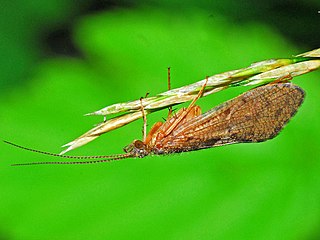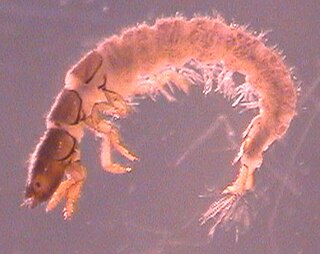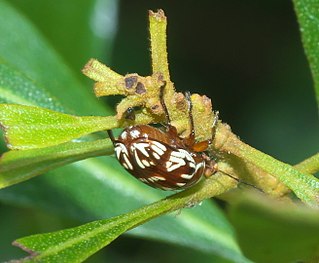
Asclepias is a genus of herbaceous, perennial, flowering plants known as milkweeds, named for their latex, a milky substance containing cardiac glycosides termed cardenolides, exuded where cells are damaged. Most species are toxic to humans and many other species, primarily due to the presence of cardenolides, although, as with many such plants, there are species that feed upon them and from them. The genus contains over 200 species distributed broadly across Africa, North America, and South America. It previously belonged to the family Asclepiadaceae, which is now classified as the subfamily Asclepiadoideae of the dogbane family, Apocynaceae.

Rhyacophila is a genus of caddisflies in the family Rhyacophilidae. There are at least 640 described species in Rhyacophila.
Beskia is a genus of bristle flies in the family Tachinidae. There is at least one described species in Beskia, B. aelops.
Epigrimyia is a genus of bristle flies in the family Tachinidae. There are at least two described species in Epigrimyia.
Eutrixa is a genus of bristle flies in the family Tachinidae. There are at least two described species in Eutrixa.
Trixodes is a genus of bristle flies in the family Tachinidae. There is at least one described species in Trixodes, T. obesus.
Vanderwulpia is a genus of bristle flies in the family Tachinidae. There are at least two described species in Vanderwulpia.

Xanthomelanodes is a genus of bristle flies in the family Tachinidae. There are at least four described species in Xanthomelanodes.
Aleurocanthus is a genus of whiteflies in the family Aleyrodidae. There are at least two described species in Aleurocanthus.
Aleurodicus is a genus of whiteflies in the family Aleyrodidae. There are at least two described species in Aleurodicus.
Glutophrissa is a genus of butterflies in the family Pieridae. There is at least one described species in Glutophrissa, G. drusilla.

Mallophora is a genus of bee killers in the family Asilidae. There are about nine described species in Mallophora.
Litobrancha is a genus of common burrower mayflies in the family Ephemeridae. There is at least one described species in Litobrancha, L. recurvata.
Anthopotamus is a genus of hacklegilled burrower mayflies in the family Potamanthidae. There are at least four described species in Anthopotamus.

Cheumatopsyche is a genus of netspinning caddisflies in the family Hydropsychidae. There are at least 240 described species in Cheumatopsyche.
Systropus is a genus of bee flies. There are about 16 described species in Systropus.

Thyridanthrax is a genus of bee flies in the family Bombyliidae. There are about 12 described species in Thyridanthrax.

Bitoma is a genus of cylindrical bark beetles in the family Zopheridae. There are about 15 described species in Bitoma.

Bassareus is a genus of case-bearing leaf beetles in the family Chrysomelidae. There are about eight described species in Bassareus.

Petridiobius arcticus is a species of jumping bristletail in the family Machilidae. It is found in Europe & Northern Asia and North America.









